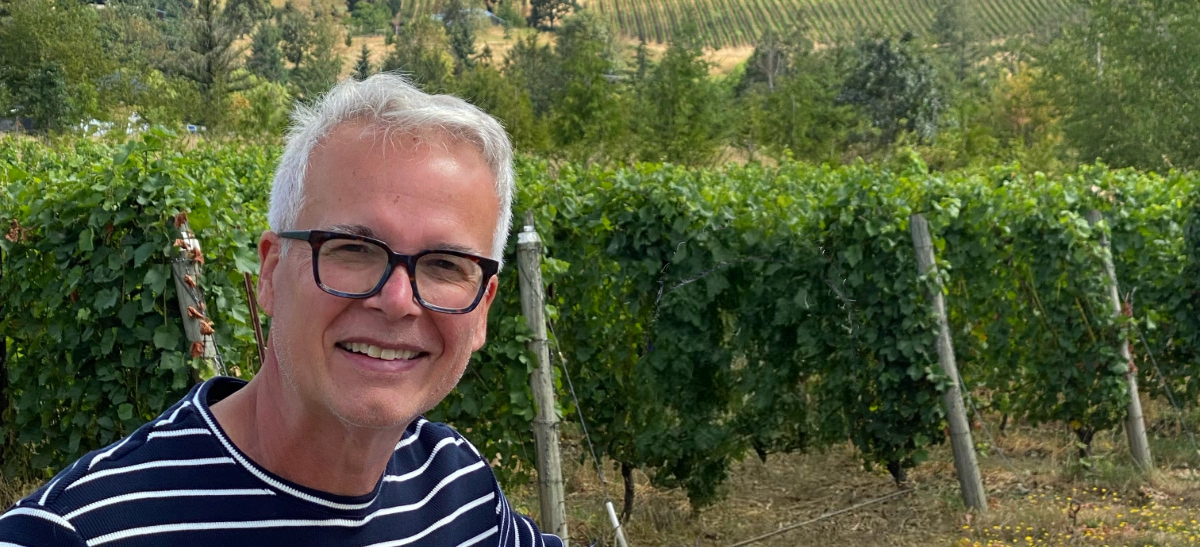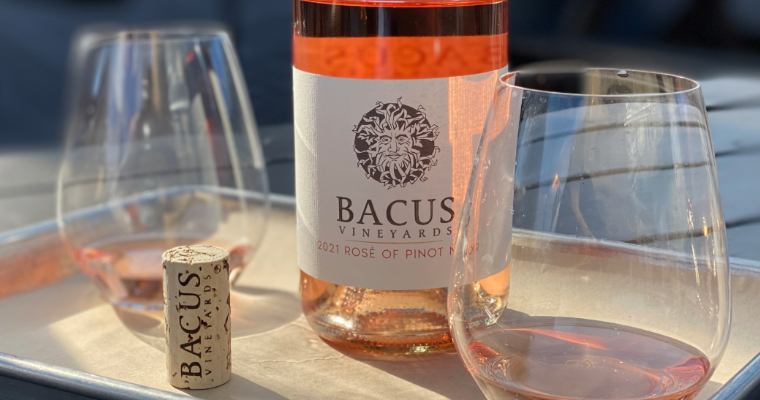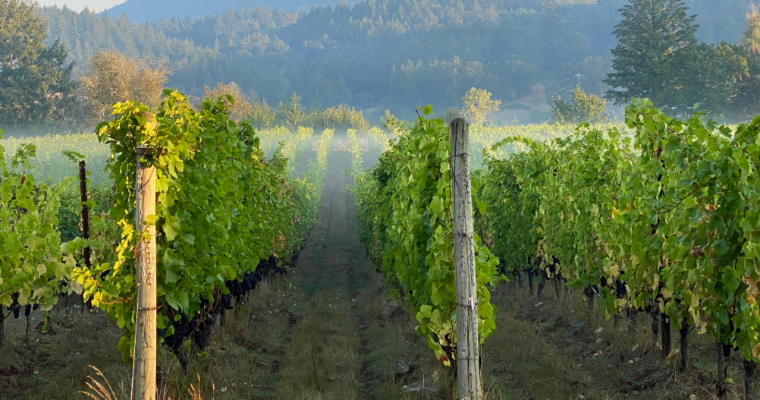Early Bird
Deadline
January 31, 2026
Judging
Date
May 18, 2026
Winners
Announced
June 10, 2026

Michael Bacus and his daughter Rachel opened Bacus Vineyards in the famed Willamette Valley of Oregon in 2019. Driven by his love of winemaking upon retirement from the tech sector, what started as a side endeavor quickly grew into a profitable family enterprise. Focusing on Pinot Noir and Chardonnay, Bacus Vineyards is dedicated to organic farming methods and limited production, producing wines that capture the terroir of the area. Michael Bacus reveals in this interview with the Sommeliers Choice Awards the motivation behind Bacus Vineyards' methodology and how it influences their wines.
[[relatedPurchasesItems-61]]
Bacus Vineyards’ commitment to small production and organic farming is rooted in the philosophy of biodynamic farming, which was championed by the estate's previous owner. After studying the principles of Rudolf Steiner, I embraced the holistic approach that sees farming as a living, evolving system. Both biodynamic and organic farming reject synthetic chemicals and focus on promoting biodiversity through native species. This philosophy has shaped our winemaking and viticulture practices, emphasizing harmony with nature and fostering a balanced, life-enriching environment. At the core of good farming is the idea of nurturing crops, which are living organisms, to express their fullest potential. Organic farming not only improves the environment but also enhances the purity and natural taste of the wine by using fewer synthetic additives. This results in fruit with more nutrients, which translates into greater flavor complexity and aromatics in the wine.
Bacus Vineyards stands out in the Chehalem Mountains AVA due to the interplay of terroir and the intentional decisions made by the vineyard owner. While environmental factors like climate, soil, and topography shape the wine's character, the choices made throughout the farming and winemaking process are equally crucial. Though many great wines are produced in our AVA, each vineyard's unique expression of terroir results in wines that can taste distinct, even when made from the same grape varieties. Differentiation within the AVA, for me, lies in how the owner expresses their vision. Winemaking is the culmination of hundreds of conscious decisions, and the key to differentiation is how those decisions align to create the final product. While our style leans toward French influences, this is a complex topic that involves many layers of decision-making and cannot be easily distilled into a single factor.

Image: 2021 Rosé of Pinot Noir
Winemaking has always been a passion of mine, and my journey began during university, where I started making wine by fermenting juice concentrate from home-brew stores. After graduation, I moved to Oregon to work directly with fruit, which greatly improved my winemaking skills. I would take my family to help with the fall grape harvest and persuade vineyard owners to sell me small batches of grape juice, which I would ferment in my garage. In 2019, my daughter Rachel, who loved those vineyard trips, reignited our dream by finding a house with a small 1.5-acre Pommard vineyard. What started as a COVID side project quickly turned into something more, and by 2020, we officially launched Bacus Vineyards with Rachel as managing partner. Our first vintage was produced in 2021, and I joined her full-time in 2023. Our vision has always been to make wines we love—aromatic, lower-alcohol wines that pair well with food. Over time, we've expanded from Pinot Noir and Chardonnay to include other varietals such as Gamay Noir, Riesling, and Cabernet Franc, along with Sparkling Brut. We're even experimenting with distillation to produce brandy. Throughout all of this, our core ethos remains the same: having fun is essential to both life and business.
The Chehalem Mountains AVA imparts a distinct character to our wines, thanks to the unique terroir shaped by ancient geological forces. Our estate vines grow on a geographic outcropping of marine sediment that dates back about 40 million years to the Eocene epoch. The Pacific Ocean plate subducted beneath the North American plate, causing the shallow ocean floor to rise. In addition, layers of volcanic basalt from Mt. Hood eruptions and sediment from the Missoula floods during the Ice Age further shaped the landscape. These diverse influences created soils rich in limestone from ancient corals, volcanic rock, and glacial deposits, all of which contribute to a strong sense of place. Pinot Noir and Chardonnay, both expressive grape varietals, thrive in this environment. The vines tap into these varied layers of mineral-rich soils, resulting in wines with a unique flavor profile that cannot be found anywhere else.
Also read: Oregon Wine Regions
Sustainability begins with the soil. Farming is inherently extractive, and if nutrients aren't replenished, vine yields will gradually decline. Vines under nutrient stress focus more on fruiting and reproduction, diverting energy away from future growth and potentially causing rapid yield loss. To prevent this, we use compost from a local worm farm to enrich the soil's organic matter and support a healthy biome. We also plant nitrogen-fixing cover crops between rows and practice low to no tillage to minimize soil disturbance. In the past, we’ve even allowed chickens to roam the vineyard, contributing to a more diverse and sustainable ecosystem.
To let our Pinot Noir and Chardonnay fully express their terroir, we take a balanced approach in the winery. While certain techniques can amplify a wine’s character, our goal is to avoid overshadowing the natural expression of the grapes. For example, when aging and fermenting with oak, we use it to enhance flavor and aromatics by allowing the wine to breathe, concentrate its flavors, and add subtle nuances. However, we avoid overusing it. For medium-bodied wines like Pinot, heavy toast levels on barrels would overpower the fruit. Instead, we exclusively use French oak with moderate toast levels and limit new barrel use to ensure the fruit flavors remain the focal point in the bottle.
Working with estate-grown fruit brings both challenges and rewards. The biggest reward is having complete control over our farming practices, allowing us to grow organically and sustainably, which makes harvest timing decisions more straightforward. After working in the vineyard for several seasons, you develop a deeper connection with the vines and a sense of their rhythm throughout the growing season. The main challenge is dealing with factors beyond our control, such as weather. Heat domes, early freezes, forest fires, smoke taint, hail, and high winds can all disrupt the growing process. Additionally, we face challenges from pests like birds, yellow jackets, gophers, voles, and invasive insects that migrate north as temperatures rise.

Image: Bacus Vineyards
Being recognized by the Sommeliers Choice Awards has been a meaningful milestone for us. When we started, our goal was simply to make wine that we enjoyed, hoping others would feel the same. The recognition has helped create broader visibility for our brand, validating our approach to winemaking. It’s allowed us to transition from a local Oregon winery to one with multi-state distribution. Similar to a positive review on a platform like Amazon, this recognition has significantly impacted our sales and marketing efforts, making it easier to attract new customers.
I’m optimistic about the future of Oregon wines, particularly in the premium and small-production sector. The industry here is still young, and there’s a lot of exciting experimentation, especially among smaller producers. One emerging trend is Chardonnay, with Oregon producing a fresher, new-world take on the classic Old World Chablis style. Additionally, the production of sparkling wines is on the rise, and we’re starting to see some exceptional Brut sparkling wines coming from Oregon. These trends show the region’s growing potential and diversity in winemaking.
Also read: Oregon's Vinous Chessboard: Navigating Quality, Sustainability and Consolidation
At Bacus Vineyards, we embrace the story of Bacchus, the Roman god of wine, as a way to communicate our vineyard’s sense of place. We are inspired by the mythology surrounding Bacchus' passion for planting vines and sharing his discovery of wine. In a way, we see ourselves as modern-day ambassadors of that original intent. This connection to Bacchus goes beyond just our family surname; it’s a story we feel deeply aligned with, and we share it with trade buyers and sommeliers to convey the passion and authenticity behind our wines.
Our winemaking style, inspired by French traditions, results in a Clarion Chardonnay that mirrors the elegance of a white Burgundy, lean and clean. When pairing wine with food, we look for both complementary and contrasting elements. One unexpected yet delightful pairing with our Chardonnay is an avocado half filled with Dungeness crab, sprinkled with salt and pepper, and a squeeze of lemon. The creaminess of the avocado contrasts with the wine’s crisp acidity, while the neutral flavor of the crab allows the wine to shine. The lemon enhances the citrus notes, creating a pairing that elevates both the dish and the wine.
Yes, we engage directly with sommeliers, wine directors, and consumers as frequently as possible. Our first brand ambassador and wine broker in Portland is a sommelier, so their input has been integral to our brand DNA. We value these interactions and continue to prioritize them through winery events, trade tastings, and educational initiatives to connect with the wine community and share our story.
We have several exciting projects in the works that wine professionals should watch for. We’re developing a Brandy that takes a Promethean approach, drawing inspiration from Bacchus' gift of wine to humanity, symbolizing the gift of fire (or water). Our Gamay Noir is tasting fabulous, and Rachel has just completed the label design artwork. We're also working on a traditional method sparkling brut, with plans for its first release in May. Additionally, we’ve planted Cabernet Franc vines at our Cherry Hill vineyard in the McMinnville AVA and we are crafting our very first Cab Franc. Lastly, we discovered a red bud sport in our Chardonnay block last year and are working on propagating it to develop a Red Chardonnay varietal.
Over the next five to ten years, Bacus Vineyards plans to expand our brand hierarchy by introducing new varietals, including Sauvignon Blanc and Cabernet Franc, to adapt to warming temperatures and climate change. We’re working on increasing sales and marketing efforts for multi-state distribution, targeting the east coast, midwest, and west coast. Additionally, we’ve partnered with plant geneticists from Oregon State University to develop disease-resistant grapevines that maintain the distinct characteristics of the original cultivars while reducing or eliminating the need for fungicide sprays during the growing season.
The key takeaway would be "Intent." At Bacus Vineyards, we begin each vintage with a clear, refined vision of what we want to achieve with each wine. We work backward from that goal, adapting as needed, and ensuring every decision aligns with our vision. From the start of the growing season, we have a plan for each wine in our brand hierarchy and optimize the variables we can control, allowing nature to shape the best wine it can offer each year.
Header image sourced from Michael Bacus
Related Links
Work Hard, Play Hard, Eat Well, Says Oregon Winemaker Spencer Spetnagel
Aaron Lieberman, Oregon Winemaker, On His Life and Winemaking
Enter your Wines now and get in front of top Sommeliers, Wine Directors, and On-Premise Wine Buyers of USA.
